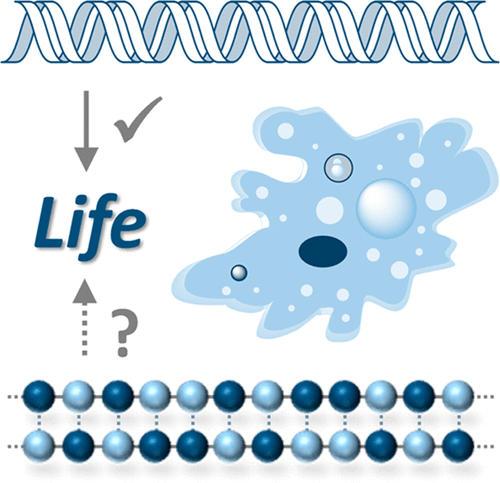当前位置:
X-MOL 学术
›
ACS Macro Lett.
›
论文详情
Our official English website, www.x-mol.net, welcomes your
feedback! (Note: you will need to create a separate account there.)
100th Anniversary of Macromolecular Science Viewpoint: Toward Artificial Life-Supporting Macromolecules
ACS Macro Letters ( IF 5.1 ) Pub Date : 2020-01-22 , DOI: 10.1021/acsmacrolett.9b00938 Jean-François Lutz 1
ACS Macro Letters ( IF 5.1 ) Pub Date : 2020-01-22 , DOI: 10.1021/acsmacrolett.9b00938 Jean-François Lutz 1
Affiliation

|
Terrestrial Life is based on polymers. In all known living organisms, DNA stores genetic information, mutates, self-replicates, and guides the synthesis of messenger molecules. Although the function of nucleic acids is well-understood, the development of artificial macromolecular mimics remains very limited. Laboratory-synthesized nucleic acids still support Life, and some nucleic acids analogues exhibit biological functions. Yet, after hundred years of polymer science, no other type of Life-supporting macromolecule (i.e., non-nucleic acids) has ever been reported. In this context, the aim of the present viewpoint is to discuss important challenges that shall be addressed by polymer chemists to achieve artificial Life. Similarly to DNA, an artificial Life-supporting macromolecule shall store information, transfer information, and mutate. Many tools, such as sequence-defined polymer synthesis, polymer modification, supramolecular polymer chemistry, and dynamic chemistry, are already available to chemists to attain these properties. However, the design of artificial Life-supporting macromolecules is hindered by two main factors. First, the chemical search space is enormous, and it is difficult to predict promising structures, even with the help of combinatorial and chemoinformatic tools. Second, rational design is probably a limited approach to achieve macromolecules that shall be involved in nonequilibrium metabolic systems. Hence, a synergic combination of classical polymer chemistry with the more recent field of systems chemistry is probably the key toward the emergence of artificial Life-supporting macromolecules.
中文翻译:

高分子科学100周年的观点:迈向人工维生大分子
陆地生命以聚合物为基础。在所有已知的生物体中,DNA 存储遗传信息、变异、自我复制并指导信使分子的合成。尽管核酸的功能已广为人知,但人工大分子模拟物的发展仍然非常有限。实验室合成的核酸仍然支持生命,一些核酸类似物表现出生物学功能。然而,经过一百年的聚合物科学,还没有报道过其他类型的生命支持大分子(即非核酸)。在这种情况下,本观点的目的是讨论高分子化学家为实现人造生命应解决的重要挑战。与 DNA 类似,人造生命支持大分子应存储信息、传递信息和变异。许多工具,例如序列定义的聚合物合成、聚合物改性、超分子聚合物化学和动态化学,已经可供化学家使用以获得这些特性。然而,人工生命支持大分子的设计受到两个主要因素的阻碍。首先,化学搜索空间巨大,很难预测有前景的结构,即使借助组合和化学信息学工具也是如此。其次,合理设计可能是一种有限的方法来获得应参与非平衡代谢系统的大分子。因此,经典聚合物化学与最近的系统化学领域的协同组合可能是人工生命支持大分子出现的关键。化学家已经可以使用聚合物改性、超分子聚合物化学和动态化学来获得这些特性。然而,人工生命支持大分子的设计受到两个主要因素的阻碍。首先,化学搜索空间巨大,很难预测有前景的结构,即使借助组合和化学信息学工具也是如此。其次,合理设计可能是一种有限的方法来获得应参与非平衡代谢系统的大分子。因此,经典聚合物化学与最近的系统化学领域的协同组合可能是人工生命支持大分子出现的关键。化学家已经可以使用聚合物改性、超分子聚合物化学和动态化学来获得这些特性。然而,人工生命支持大分子的设计受到两个主要因素的阻碍。首先,化学搜索空间巨大,很难预测有前景的结构,即使借助组合和化学信息学工具也是如此。其次,合理设计可能是一种有限的方法来获得应参与非平衡代谢系统的大分子。因此,经典聚合物化学与最近的系统化学领域的协同组合可能是人工生命支持大分子出现的关键。然而,人工生命支持大分子的设计受到两个主要因素的阻碍。首先,化学搜索空间巨大,很难预测有前景的结构,即使借助组合和化学信息学工具也是如此。其次,合理设计可能是一种有限的方法来获得应参与非平衡代谢系统的大分子。因此,经典聚合物化学与最近的系统化学领域的协同组合可能是人工生命支持大分子出现的关键。然而,人工生命支持大分子的设计受到两个主要因素的阻碍。首先,化学搜索空间巨大,很难预测有前景的结构,即使借助组合和化学信息学工具也是如此。其次,合理设计可能是一种有限的方法来获得应参与非平衡代谢系统的大分子。因此,经典聚合物化学与最近的系统化学领域的协同组合可能是人工生命支持大分子出现的关键。其次,合理设计可能是一种有限的方法来获得应参与非平衡代谢系统的大分子。因此,经典聚合物化学与最近的系统化学领域的协同组合可能是人工生命支持大分子出现的关键。其次,合理设计可能是一种有限的方法来获得应参与非平衡代谢系统的大分子。因此,经典聚合物化学与最近的系统化学领域的协同组合可能是人工生命支持大分子出现的关键。
更新日期:2020-01-23
中文翻译:

高分子科学100周年的观点:迈向人工维生大分子
陆地生命以聚合物为基础。在所有已知的生物体中,DNA 存储遗传信息、变异、自我复制并指导信使分子的合成。尽管核酸的功能已广为人知,但人工大分子模拟物的发展仍然非常有限。实验室合成的核酸仍然支持生命,一些核酸类似物表现出生物学功能。然而,经过一百年的聚合物科学,还没有报道过其他类型的生命支持大分子(即非核酸)。在这种情况下,本观点的目的是讨论高分子化学家为实现人造生命应解决的重要挑战。与 DNA 类似,人造生命支持大分子应存储信息、传递信息和变异。许多工具,例如序列定义的聚合物合成、聚合物改性、超分子聚合物化学和动态化学,已经可供化学家使用以获得这些特性。然而,人工生命支持大分子的设计受到两个主要因素的阻碍。首先,化学搜索空间巨大,很难预测有前景的结构,即使借助组合和化学信息学工具也是如此。其次,合理设计可能是一种有限的方法来获得应参与非平衡代谢系统的大分子。因此,经典聚合物化学与最近的系统化学领域的协同组合可能是人工生命支持大分子出现的关键。化学家已经可以使用聚合物改性、超分子聚合物化学和动态化学来获得这些特性。然而,人工生命支持大分子的设计受到两个主要因素的阻碍。首先,化学搜索空间巨大,很难预测有前景的结构,即使借助组合和化学信息学工具也是如此。其次,合理设计可能是一种有限的方法来获得应参与非平衡代谢系统的大分子。因此,经典聚合物化学与最近的系统化学领域的协同组合可能是人工生命支持大分子出现的关键。化学家已经可以使用聚合物改性、超分子聚合物化学和动态化学来获得这些特性。然而,人工生命支持大分子的设计受到两个主要因素的阻碍。首先,化学搜索空间巨大,很难预测有前景的结构,即使借助组合和化学信息学工具也是如此。其次,合理设计可能是一种有限的方法来获得应参与非平衡代谢系统的大分子。因此,经典聚合物化学与最近的系统化学领域的协同组合可能是人工生命支持大分子出现的关键。然而,人工生命支持大分子的设计受到两个主要因素的阻碍。首先,化学搜索空间巨大,很难预测有前景的结构,即使借助组合和化学信息学工具也是如此。其次,合理设计可能是一种有限的方法来获得应参与非平衡代谢系统的大分子。因此,经典聚合物化学与最近的系统化学领域的协同组合可能是人工生命支持大分子出现的关键。然而,人工生命支持大分子的设计受到两个主要因素的阻碍。首先,化学搜索空间巨大,很难预测有前景的结构,即使借助组合和化学信息学工具也是如此。其次,合理设计可能是一种有限的方法来获得应参与非平衡代谢系统的大分子。因此,经典聚合物化学与最近的系统化学领域的协同组合可能是人工生命支持大分子出现的关键。其次,合理设计可能是一种有限的方法来获得应参与非平衡代谢系统的大分子。因此,经典聚合物化学与最近的系统化学领域的协同组合可能是人工生命支持大分子出现的关键。其次,合理设计可能是一种有限的方法来获得应参与非平衡代谢系统的大分子。因此,经典聚合物化学与最近的系统化学领域的协同组合可能是人工生命支持大分子出现的关键。





















































 京公网安备 11010802027423号
京公网安备 11010802027423号